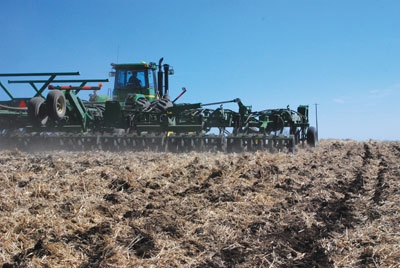
Features
Agronomy
Cereals
Diversity can be a good thing
Arecent study completed at the University of Alberta found that production practices can affect soil microbial diversity. The research team led by Alison Nelson, and including Dean Spaner, Sylvie Quideau, Jill Clapperton, David Niziol and Brenda Frick, wanted to see if there are connections between production practices, the soil microbial community and crop quality.
To answer the question, we compared five Canadian spring wheat cultivars grown under organic and conventional management systems for yield, breadmaking quality and soil microbial community. We found that production practice differences between the organic and conventional systems led to differences in the soil microbial communities, and that wheat cultivars varied in yield, quality and microbial measures. The organic system, with higher plant diversity in the plots from weeds, had higher soil microbial diversity.
With a greater understanding of the interconnections within the cropping system, there may be potential to manage a system to promote the presence of beneficial soil microbes and high quality crops.
Management systems lead to differences in wheat yield and quality
The wheat cultivars were grown on two nearby plots of land that had all been managed either organically or conventionally for the previous five years. By comparing two closely located plots, we ensured that differences between the two management systems were due to differences in production practices, not differences in soil type or climate.
Production practice differences between the two systems led to differences in yield and grain quality. The organic system used tillage, crop rotation and delayed seeding for weed control, but had no in-crop weed control. The conventional system used herbicides and was seeded earlier in the spring. Manure was used as a soil fertility amendment in the organic system, whereas the conventional system relied on chemical fertilizers. Organic wheat yields were 2.74 tonnes per hectare, roughly half of conventional yields at 5.02 tonnes per hectare, but protein levels were higher in the organic system at 16.6 percent compared to the conventional grain with 15.3 percent protein.
The newest cultivar in the study, AC Superb, had the highest organic and conventional yields, whereas the oldest cultivar, Marquis, had the lowest yields in both systems of production. Cultivars varied in breadmaking quality traits, but most were within acceptable levels for Canadian Western Red Spring wheat, indicating that all the chosen cultivars would produce quality bread wheat in both organic and conventional systems of production.
Microbial communities altered by management systems and wheat cultivars
One of our primary interests in this study was to see if the management systems altered the soil microbial community. The two systems did have different soil microbial communities, and because of the close pairing of the two research sites, we can reasonably assume those differences were due to production practice differences. The organic system had higher levels of bacteria, fungi (including beneficial arbuscular mycorrhizal fungi) and diversity in the soil microbial community. The presence of mycorrhizal fungi in our study was positively associated with yield and some breadmaking quality attributes in the organic system, where nutrients may not be as readily available as in conventional systems.
Other research has shown that increased soil organic matter and greater plant diversity can lead to higher microbial populations and more diverse microbial communities. Increased aboveground diversity can cause a corresponding increase in belowground diversity, because soil microbes feed on plant material and with more plant species there is greater variety of food available. Weeds created greater aboveground diversity in the organic system, and we calculated that microbial diversity was, in fact, related to the presence of weeds in this study.
Using composted manure in the organic system may have also played a role in the observed differences in soil microbial communities between the two cropping systems, because manure is a direct addition of organic matter to the soil system.
A surprising and exciting result from this research was that the newest wheat cultivar in the study, Superb, had the highest levels of mycorrhizal fungi associated with the roots in the conventional system. Arbuscular mycorrhizal fungi form mutually beneficial associations with many crops, including wheat, and exchange nutrients such as phosphorus for plant carbon products. Other studies have suggested that mycorrhizal dependency is being bred out of modern wheat cultivars.
Our results suggest that breeding efforts in conventional environments have cultivated mycorrhizal dependence in that environment.
Positive, negative effects of weeds
In this study, we saw that increased soil microbial diversity often led to decreased wheat yield and breadmaking quality measures. Weeds helped increase soil microbial diversity in the organic system, so some of the negative effects of diversity on yield can be attributed to the presence of weeds. We know that the presence of weeds in a field can lower yields, and possibly crop quality as well. So, the positive benefits from weeds (such as an increase in microbial diversity) were tempered by the impact of the weeds on crop yield and quality.
*Editor’s note: This article is based on the Canadian Journal of Plant Sciences “best agronomy article” for 2011.
November 22, 2012 By Alison Nelson Agronomist Canada-Manitoba Crop Diversification Centre*
 Cropping diversity Arecent study completed at the University of Alberta found that production practices can affect soil microbial diversity.
Cropping diversity Arecent study completed at the University of Alberta found that production practices can affect soil microbial diversity.